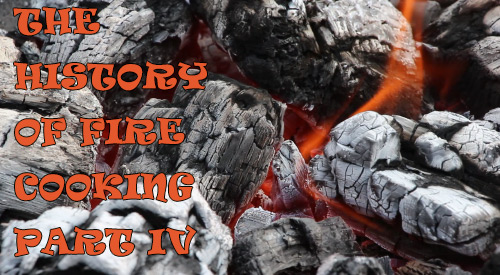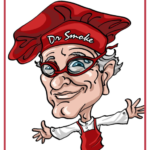Wed 14 Mar 2018
THE HISTORY OF FIRE COOKING PART IV
Posted by DrSmokeRead other related stories: Cooking With Wood , General Smoking Information
No Comments

THE HISTORY OF FIRE COOKING PART IV
THE HISTORY OF FIRE COOKING PART IV

In THE HISTORY OF FIRE COOKING PART IV, we examine how wood fired cooking has evolved around the world, focusing on those countries who still rely solely or in great part on wood fired cooking for sustenance.
Many Still Rely on Fire
The numbers can be staggering when you take a close look. In developing countries, some 2.5 billion people rely on biomass to meet their energy needs for cooking. For many, these resources account for over 90% of the household energy consumption. Biomass includes charcoal (derived from wood), fuel wood, agricultural waste, and animal dung. As area populations increase, the number of people relying on biomass for cooking also grows. By the year 2030, it is estimated that 2.7 billion people will relay on biomass for cooking! The immediate concerns are that biomass will be used without sustaining harvests and that technologies for energy conversion will not be used properly. In fact, 1.3 million people, the majority of whom are women and children, die because of exposure to indoor air pollutants from biomass. Slowly, the goal for switching to modern cooking fuels and/or promoting more efficient and sustainable use of traditional biomass is under way. For now, there are millions who wood fire foods for their family’s nutrition using traditional methods and recipes.
The History of Fire Cooking Part IV- The Many Methods and Meals of Fire Cooking
Without question, the continent of Africa houses most of the countries who are reliant on wood fires for cooking. The top 12 countries using wood fires for cooking are: Guinea-Bissau, Mali, Rwanda, Burundi, Liberia, Madagascar, Sierra Leone, South Sudan, Guinea, Laos, Ethiopia, and Central African Republic. However, there are many other countries that carry generations of wood fired cooking recipes into today, making them a family gathering special occasion. Let’s examine some of those countries and what they cook.
Morocco
Moroccans cook in earthen ovens called tagine, a conical shaped terra-cotta lid that sits on a flat terra cotta bottom. It sits on a base called a majmar, an unglazed brazier full of hot coals that cooks the tagine slowly. In the market place, tagines are lined up with various foods like fish & potatoes, chicken & olives and lemon, or lamb with prunes. They also use small elevated grills in the port areas to cook various fish.
Laos
Although the people of Laos do grill some items, including water beetles, they mostly make soup in large pots set over an open wood fire. This is much like the American style of cowboy cooking. Vegetables, sprouts, and noodles are often added to the broth to make the traditional Laotian daily dish.
Guatemala
Guatemalans use a method of wood cooking known as three stone cooking. A fire is started between 3 fire proof materials, usually stones that are used to support pots placed over the fire. Pepian, the national dish of Guatemala, is a mouth-watering chicken stew made with different types of native chilis, seeds, and vegetables. In addition to hand-crafted tortillas, it takes 3-4 hours to make this recipe traditionally over a fire.
Argentina
Here they call barbecue asado and it is certainly about the meat. Vegetables, calamari, bread, and other foods are introduced to fire and heated either on heavy grates or iron pans.
India
One of the biggest misconceptions is that tandoori is a recipe from India. That couldn’t be further from the truth. Tandoori is a technique of grilling meat over fire in a tandoor, a clay oven. The tandoor is buried. Heat escapes from the top. Tandoori is very hot! Skewered meat or fish is inserted into the tandoor vertically to cook. The traditional bread, Naan, is placed along the sides of the clay vessel.
Korea
Koreans use a very unique method of wood fire cooking while at the same time utilizing the heat from that fire to heat their homes. They are one of the earliest users of radiant heat. Outside the home, a fire proof container is hung over the fire area. A series of flues travel horizontally under the house. Ondol is a layer of flat stone located directly beneath the house floor. A chimney flue is located on the opposite side of the house from the fire source preventing any smoke from entering the actual home. As the smoke travels through the underground flue system, it acts as a preservative to the wood house by preventing insects, mold, and bacteria from developing.
Don’t Think All Wood-Fired Cooking is BBQ
The variety of foods and techniques noted are not considered BBQ but have traditions that originate in every corner of the world. Through trial and error, sourcing material that was available in each country, and incorporating foods and other edible items into recipes to feed families, fire cooking has advanced in some countries, while others still have seen little change.
Now we see the essence of barbecue by other names in other countries. Asado in Argentina, braai in South Africa, lechon in Philippines, mezze in Lebanon, and parrilla in Uruguay. Without question, the days of fire cooking are far from over as our innate nature seeks the flavors only provide by flame and smoke. Hope you enjoyed THE HISTORY OF FIRE COOKING PART IV, the final installment of the fire history series.
Purchase Products:
Wood Chips- Grande Sapore®
Wood Chunks- Double & Single Filet

More Related reading on “What Wood for Smoking” and other great smoking and grilling tips and techniques
Additional Reading:
-THE HISTORY OF FIRE COOKING PART III
-THE HISTORY OF FIRE COOKING PART II
-OPEN PIT COOKING FIRE BUILDING: PART I

Dr Smoke “Hope you enjoyed the variety of cultures that have roots in wood cooking.”